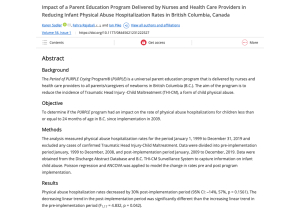Displaying items by tag: purple
PURPLE Program Decreased Infant Physical Abuse by 30% in BC, Canada
The Period of PURPLE Crying shaken baby syndrome/abusive head trauma prevention program shows an additional benefit in preventing general physical abuse
(British Columbia, Canada and Farmington, UT, USA) - According to the Canadian General Social Survey 2014, a national survey of self-reported victimization, 26% of respondents identified having experienced physical abuse or witnessed physical abuse before age 15. Physical abuse among children is defined as any physical force or action that results or could result, in injury to a child by a caregiver. The Period of PURPLE Crying program was implemented in British Columbia (BC), Canada in 2009, in an effort to prevent infant traumatic head injury due to child maltreatment (THI-CM) commonly known as shaken baby syndrome/abusive head trauma (SBS/AHT).
In a 2018 study, an 8-year evaluation showed the Period of PURPLE Crying program was associated with a 35% reduction in THI-CM hospitalization rates among children aged 0-24 months after it was implemented in BC. “Because THI-CM is a subset of physical abuse, we hypothesized that if the program reduced THI-CM hospitalizations, it may have also reduced physical abuse hospitalizations,” said the program director, Dr. Ian Pike.
And they were right. The research team recently published a manuscript in the Canadian Journal of Nursing Research demonstrating hospitalization rates for physical abuse, for children 24 months of age or younger in BC, decreased by 30% after the Period of PURPLE Crying program was universally implemented.
“The Period of PURPLE Crying teaches parents and other caregivers that inconsolable crying in a baby that starts at two weeks of age, peaks or is the most at about two months of age and ends at about four to five months is a normal part of a baby’s development,” says Danielle Vazquez, executive director of the National Center on Shaken Baby Syndrome (NCSBS) located in Farmington, Utah. The NCSBS, in partnership with Developmental Pediatrician Dr. Ronald G. Barr, developed the Period of PURPLE Crying program.
Inconsolable crying is the number one trigger for SBS/AHT. This most often occurs when a parent or caregiver gets so frustrated with the baby’s crying that they become angry and shake the baby or injure the baby in a way that causes serious brain injury.
“The program's key messages emphasize that crying is a normal and healthy way for infants to communicate and provides parents with tools and strategies for responding to crying in a positive and supportive way. So, it makes sense that the Period of PURPLE Crying key messages such as putting the baby down to take a break when you get frustrated with the crying, that all babies go through this period of increased crying, and that it’s ok if you can’t stop the baby’s crying, would work to help reduce the frustration that can lead to physical abuse,” says Dr. Pike.
The organization Prevent Shaken Baby Syndrome British Columbia (PSBSBC) housed with the BC Injury Research and Prevention Unit oversaw the implementation of the Period of PURPLE Crying program in all birthing healthcare institutions in BC. Nurses are given training on the Period of PURPLE Crying as part of their onboarding process. Maternity nurses spend approximately five minutes providing PURPLE education to parents of new babies, and public health/community nurses communicate key messages during infant follow-up appointments. PSBSBC provides continuous training support and ensures that those who provide the PURPLE program to families are following best practices.
“The ability to make the Period of PURPLE Crying program universal in BC as well as the diligence of the nurses who provide the program to new families was critical to the program’s success,” says Dr. Pike.
Read the study abstract online at: https://journals.sagepub.com/doi/10.1177/08445621231222527
About the National Center on Shaken Baby Syndrome
Founded in 2000, the National Center on Shaken Baby Syndrome (NCSBS) is a non-profit 501(c)3 public charity with a mission to “The National Center on Shaken Baby Syndrome commits to prevent shaken baby syndrome / abusive head trauma and promote the well-being of infants through supporting and educating families, caregivers and professionals.”
The NCSBS works nationally and internationally with hospitals, public health, pediatricians, social workers, home visitors and other similarly aligned individuals and organizations to provide education and resources to families and professionals that will ultimately keep babies safe. The NCSBS is a leader in the development of shaken baby syndrome/abusive head trauma (SBS/AHT) prevention programs, training courses and public education campaigns. Each year, the National Center's resources and services reach over a million people worldwide. For more information, please visit www.dontshake.org.
About Prevent Shaken Baby Syndrome British Columbia
Prevent Shaken Baby Syndrome BC (PSBSBC) is a program of the BC Injury Research and Prevention Unit at BC Children’s Hospital. PSBSBC delivers a primary prevention program to reduce the incidence of shaken baby syndrome in British Columbia. We do this by providing timely, relevant, and scientifically sound information to parents, caregivers, and professionals involved in THI-CM cases, including: maternity nurses, health care professionals, and social workers.
PSBSBC was created out of the BC Children’s Hospital Steering Committee on Shaken Baby Syndrome that formed in early 2003 to examine the need and potential of a standardized prevention program for BC. A provincial environmental scan was completed, followed by a large three-year randomized-controlled trial. It was determined that the Period of PURPLE Crying® program (PURPLE) was the best program to educate new parents and caregivers. PSBSBC has been implementing the PURPLE program in throughout BC since 2009, resulting in reducing the rate of THI-CM/SBS in BC. For more information visit https://dontshake.ca.



Donate